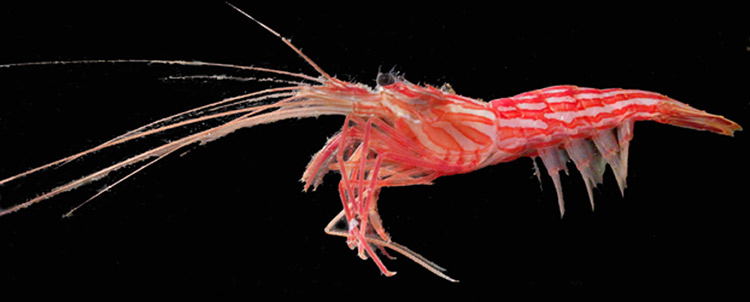
Study Reveals Ocean Acidification’s Effects on Shrimp Biology
Increased acidity linked to more calcium in shrimp shells and decreased shrimp transparency
Published Date
By:
- Christina Wu
Share This:
Article Content

Red rock shrimp
A new study by Scripps Institution of Oceanography at UC San Diego researchers reveals that more carbon dioxide in seawater could lead to more calcium in shrimp exoskeletons and a decrease in their transparency.
The study appears in the June 1 issue of Scientific Reports, an open access journal published by Nature.
Researchers collected red rock shrimp from the water around Scripps Pier and compared their exoskeletons (shells) for chemical composition as well as transparency between animals kept in control and reduced pH conditions.
Shrimp rely on their shells to cover, support, and protect their internal soft bodies. Rock shrimp also use transparency between patches of colors to camouflage themselves from predators. The results of this study indicate that ocean acidification may adversely impact the rock shrimp’s biomechanical properties and its ability to avoid predators either through camouflage or escape behavior.
Previous Scripps Oceanography studies have indicated potentially negative effects of ocean acidification on juvenile rockfish and fish ear bones. This is the first study to examine the effects of lower pH on shrimp transparency, exoskeleton structure, and chemistry.
“The effects are variable among crustaceans. This was the first study to consider other physiological changes to a species of shrimp in such acidified conditions,” said Scripps Oceanography marine biologist Jennifer Taylor, the study’s lead author.
Taylor and fellow Scripps Oceanography marine biologist Dimitri Deheyn observed the presence of more calcium in shrimp shells and reduced shrimp transparency.
“Transparency is an important function for the shrimp because they rely on it for ecology,” said Deheyn. “This study indicates that ocean acidification could have an impact on the visual ecology of crustaceans.”
Crustaceans are usually more resilient to environmental changes than other organisms but here, in just three weeks, the red rock shrimp showed increased shell calcification and decreased transparency, leading to more obvious contrast with the color patches in the background environment; an important species-specific recognition pattern and critical for interaction with other organisms.
“The results from this experiment were surprising because they show us that ocean acidification can rapidly affect crustaceans regarding their morphology and visual ecology,” said Deheyn.
Despite the surprising results, both researchers agree that further studies are needed in this area.
“There’s clearly more research to be done about the ecological impacts of increased acidity on marine life,” said Taylor.
The research included funding support from the Scripps Undergraduate Research Fellowship (SURF) and the Air Force Office of Scientific Research.
The study was conducted by Jennifer Taylor, Dimitri Deheyn, and Michael Allen at Scripps Oceanography, and Jasmine Gilleard from the University of Montana (NSF SURF student).
Share This:
You May Also Like
Stay in the Know
Keep up with all the latest from UC San Diego. Subscribe to the newsletter today.



